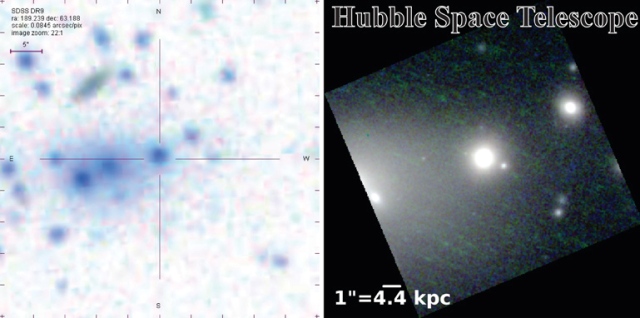Sep 16 2013
In 2005 the Hubble Space Telescope spotted unusually small galaxies densely packed with red stars in the distant, young universe. They were nicknamed "red nuggets," not only because they are small and red but also their existence challenged current theories of galaxy formation, making them precious in astronomers' eyes.
 These images highlight the most massive of the newly discovered compact galaxies known as "red nuggets." The photo at left from the Sloan Digital Sky Survey shows that the galaxy is so small it appears starlike. The higher resolution photo at right from the Hubble Space Telescope reveals the object's true, extended shape. Credit: SDSS (left), NASA (right)
These images highlight the most massive of the newly discovered compact galaxies known as "red nuggets." The photo at left from the Sloan Digital Sky Survey shows that the galaxy is so small it appears starlike. The higher resolution photo at right from the Hubble Space Telescope reveals the object's true, extended shape. Credit: SDSS (left), NASA (right)
Since no "red nuggets" were seen nearby, astronomers wondered why they had disappeared over time. New research shows that they didn't disappear completely. In fact, they were simply hidden within the data of previous surveys.
Astronomers now realize these newfound compact galaxies could represent a missing link between distant "red nuggets" and nearby elliptical galaxies. They may light the evolutionary path to show how compact galaxies age over time and reveal whether they become the "seeds" for the monster ellipticals we see today.
To find them, astronomer Ivana Damjanov (Harvard-Smithsonian Center for Astrophysics) and her colleagues searched databases from the Sloan Digital Sky Survey. The "red nugget" galaxies are so small that they appear like stars in photographs from ground-based telescopes. However, their spectra give away their true nature.
"Looking for 'red nuggets' in the Sloan Digital Sky Survey was like panning a riverbed, washing away silt and mud to uncover bits of gold," says Damjanov.
By sifting through the Sloan data, the team dug up more than 600 "red nugget" candidates. They are located at distances of 2.5 to 5.7 billion light-years from Earth.
Damjanov then investigated the Hubble Space Telescope database to find photos of the patches of sky where those objects were located. Serendipitous images of nine targets confirmed that they are as compact as more distant "red nugget" galaxies. The most massive weigh up to 10 times more than the Milky Way, but are up to 10 times smaller than our galaxy. As a result, they're called compact, massive galaxies.
"We think there are more of these red nuggets, or compact galaxies, hidden in the universe, waiting to be discovered," says co-author Ho Seong Hwang (Smithsonian Astrophysical Observatory).
The team's future plans include using the Hubble Space Telescope to investigate more of these compact, massive galaxies to answer questions like: Where do they live, near other galaxies or in the intergalactic void? What is their internal structure?
Damjanov, a Menzel Fellow at the Harvard College Observatory, is lead author on the paper, which has been accepted for publication in The Astrophysical Journal Letters. Her co-authors are Igor Chilingarian, Ho Seong Hwang, and Margaret Geller (Smithsonian Astrophysical Observatory).
Headquartered in Cambridge, Mass., the Harvard-Smithsonian Center for Astrophysics (CfA) is a joint collaboration between the Smithsonian Astrophysical Observatory and the Harvard College Observatory. CfA scientists, organized into six research divisions, study the origin, evolution and ultimate fate of the universe.